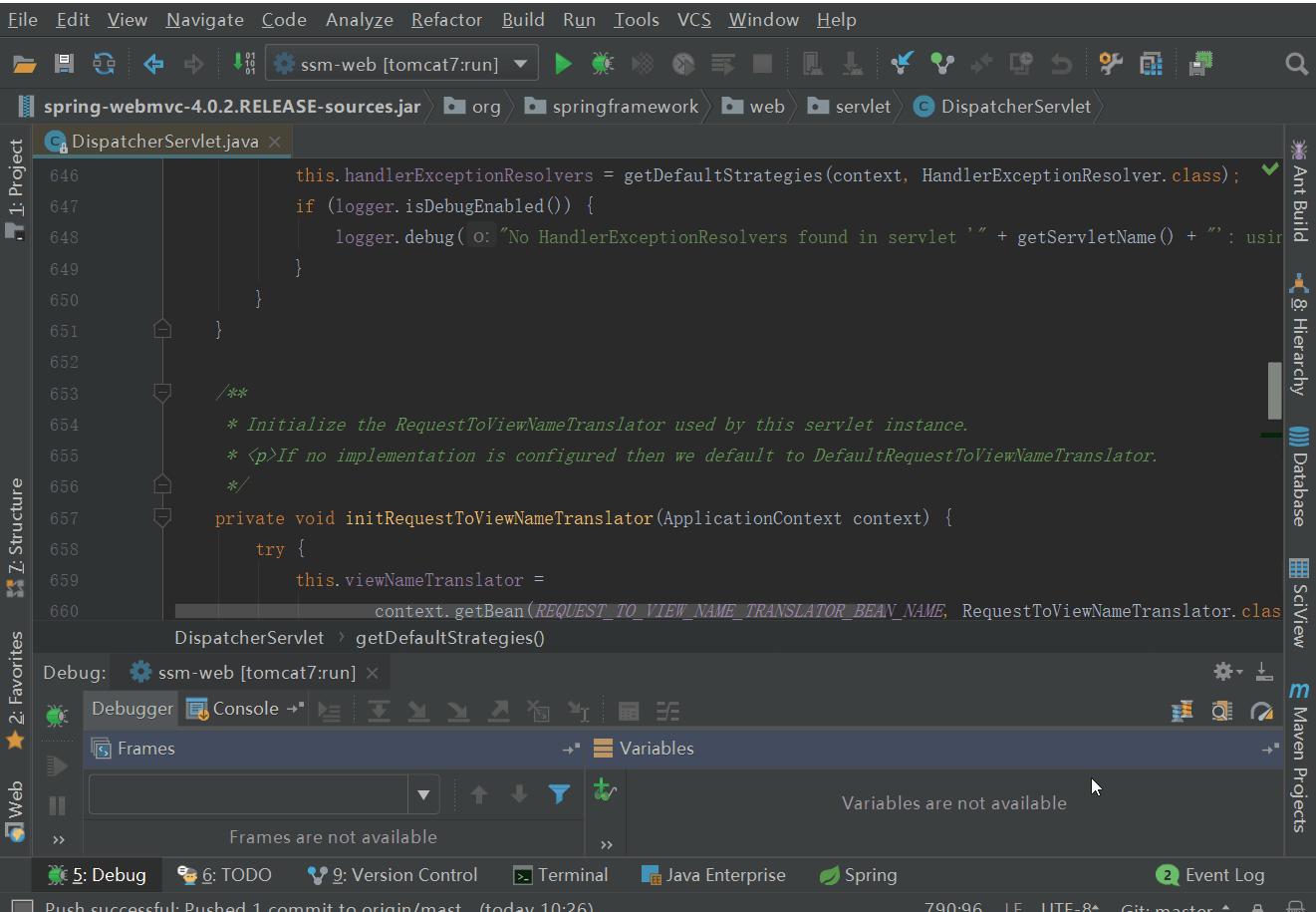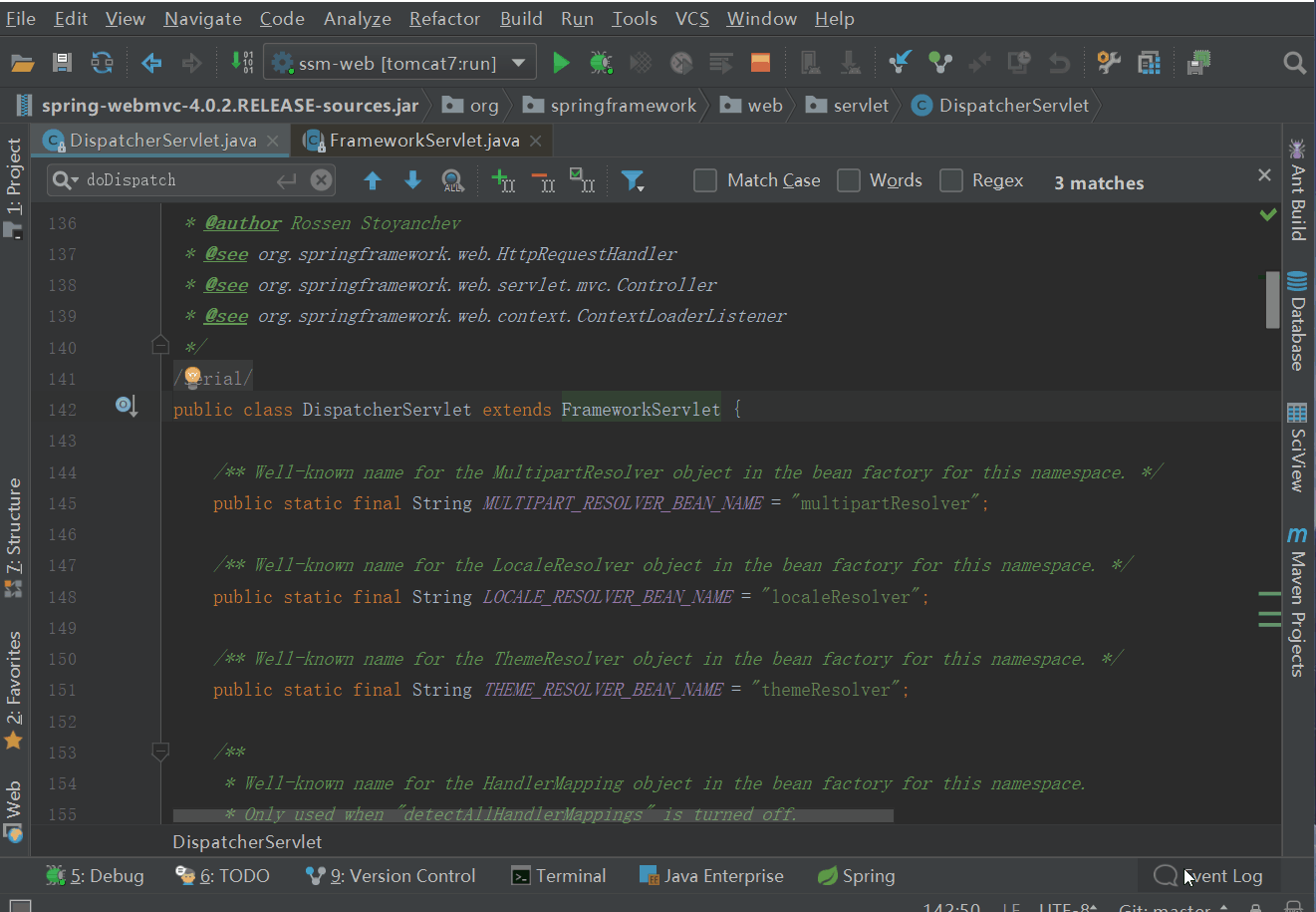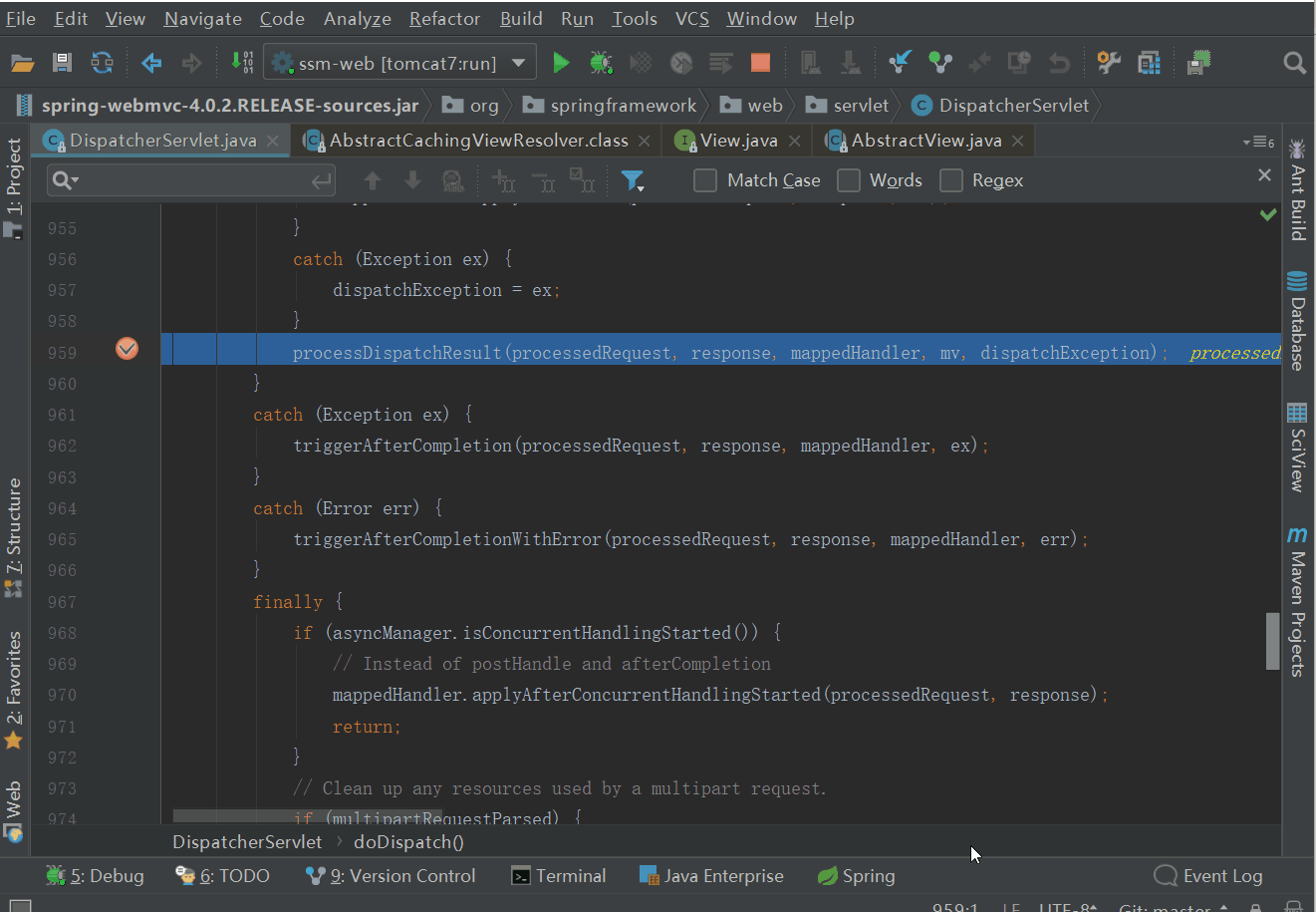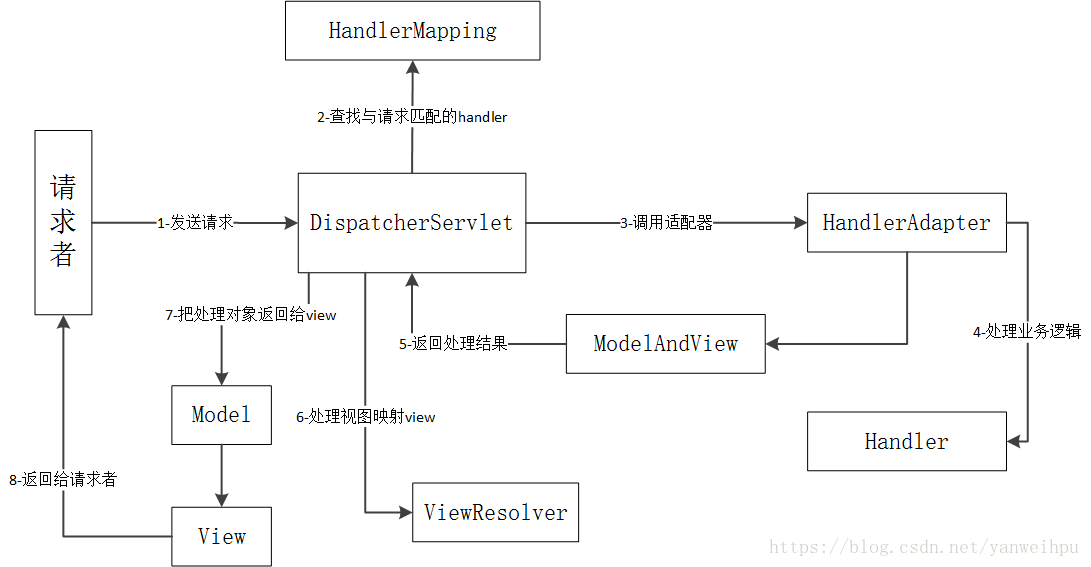小编给大家分享一下Spring MVC工作原理的示例分析,相信大部分人都还不怎么了解,因此分享这篇文章给大家参考一下,希望大家阅读完这篇文章后大有收获,下面让我们一起去了解一下吧!
应用示例
在讲工作原理之前,我们先看一个简单的spring mvc(ssm)示例,以及实现的效果
工程代码地址:ssm-web

工程结构与效果如上所示,我们不做过多的探究,我们打起精神往下看本篇的重点
工作原理
准备 - 资源的加载与初始化
1、DispatcherServlet 静态初始化
DispatcherServlet中有如下静态块
static {
// Load default strategy implementations from properties file.
// This is currently strictly internal and not meant to be customized
// by application developers.
try {
ClassPathResource resource = new ClassPathResource(DEFAULT_STRATEGIES_PATH, DispatcherServlet.class);
defaultStrategies = PropertiesLoaderUtils.loadProperties(resource);
}
catch (IOException ex) {
throw new IllegalStateException("Could not load 'DispatcherServlet.properties': " + ex.getMessage());
}
}这里会将DispatcherServlet.properties中的内容读取到DispatcherServlet的属性:private static final Properties defaultStrategies中,DispatcherServlet.properties内容如下
# Default implementation classes for DispatcherServlet's strategy interfaces. # Used as fallback when no matching beans are found in the DispatcherServlet context. # Not meant to be customized by application developers. org.springframework.web.servlet.LocaleResolver=org.springframework.web.servlet.i18n.AcceptHeaderLocaleResolver org.springframework.web.servlet.ThemeResolver=org.springframework.web.servlet.theme.FixedThemeResolver org.springframework.web.servlet.HandlerMapping=org.springframework.web.servlet.handler.BeanNameUrlHandlerMapping,\ org.springframework.web.servlet.mvc.annotation.DefaultAnnotationHandlerMapping org.springframework.web.servlet.HandlerAdapter=org.springframework.web.servlet.mvc.HttpRequestHandlerAdapter,\ org.springframework.web.servlet.mvc.SimpleControllerHandlerAdapter,\ org.springframework.web.servlet.mvc.annotation.AnnotationMethodHandlerAdapter org.springframework.web.servlet.HandlerExceptionResolver=org.springframework.web.servlet.mvc.annotation.AnnotationMethodHandlerExceptionResolver,\ org.springframework.web.servlet.mvc.annotation.ResponseStatusExceptionResolver,\ org.springframework.web.servlet.mvc.support.DefaultHandlerExceptionResolver org.springframework.web.servlet.RequestToViewNameTranslator=org.springframework.web.servlet.view.DefaultRequestToViewNameTranslator org.springframework.web.servlet.ViewResolver=org.springframework.web.servlet.view.InternalResourceViewResolver org.springframework.web.servlet.FlashMapManager=org.springframework.web.servlet.support.SessionFlashMapManager
指定了DispatcherServlet策略接口的默认实现,后续DispatcherServlet初始化策略的时候会用到
2、interceptor定义的加载
spring启动过程中会调用InterceptorsBeanDefinitionParser的parse方法来解析出我们自定义的interceptor定义,封装成MappedInterceptor类型的bean定义,并放到spring容器中;我们可以简单的认为spring容器中已经存在了我们自定义的interceptor的bean定义
3、DispatcherServlet初始化策略:initStrategies
DispatcherServlet的继承图如下

DispatcherServlet是一个Servlet,tomcat启动过程中会调用其init方法,一串的调用后,会调用DispatcherServlet的initStrategies方法
protected void initStrategies(ApplicationContext context) {
initMultipartResolver(context);
initLocaleResolver(context);
initThemeResolver(context);
initHandlerMappings(context);
initHandlerAdapters(context);
initHandlerExceptionResolvers(context);
initRequestToViewNameTranslator(context);
initViewResolvers(context);
initFlashMapManager(context);
}实例化步骤1中的默认实现,并填充到DispatcherServlet各个属性值中
4、DefaultAnnotationHandlerMapping的拦截器初始化
DispatcherServlet.properties种指定了两个默认的HandlerMapping:BeanNameUrlHandlerMapping、DefaultAnnotationHandlerMapping,这两者的类继承图如下(我们暂时只关注DefaultAnnotationHandlerMapping)

DefaultAnnotationHandlerMapping间接实现了ApplicationContextAware,那么在DefaultAnnotationHandlerMapping实例初始化过程中,会调用setApplicationContext(ApplicationContext applicationContext)方法,一串调用后,会来到AbstractUrlHandlerMapping的initApplicationContext()
@Override
protected void initApplicationContext() throws BeansException {
extendInterceptors(this.interceptors);
detectMappedInterceptors(this.mappedInterceptors);
initInterceptors();
}初始化了DefaultAnnotationHandlerMapping的拦截器:interceptor
我们来看下具体的初始化过程,看看上面的顺序是否只是我个人的臆想?

可以看到,初始化顺序就是我们上面说的,不是我个人的意淫;此时的DefaultAnnotationHandlerMapping中有我们自定义的MyInterceptor。初始化过程我们需要关注的就是上述这些,下面我们一起看看具体请求的过程
请求的处理
请求从servlet的service开始,一路到DispatcherServlet的doDispatch,如下图

doDispatch
/**
* Process the actual dispatching to the handler. 将请求分发到具体的handler,也就是我们的controller
* <p>The handler will be obtained by applying the servlet's HandlerMappings in order.
* The HandlerAdapter will be obtained by querying the servlet's installed HandlerAdapters
* to find the first that supports the handler class.
* <p>All HTTP methods are handled by this method. It's up to HandlerAdapters or handlers
* themselves to decide which methods are acceptable.
* @param request current HTTP request
* @param response current HTTP response
* @throws Exception in case of any kind of processing failure
*/
protected void doDispatch(HttpServletRequest request, HttpServletResponse response) throws Exception {
HttpServletRequest processedRequest = request;
HandlerExecutionChain mappedHandler = null;
boolean multipartRequestParsed = false;
WebAsyncManager asyncManager = WebAsyncUtils.getAsyncManager(request);
try {
ModelAndView mv = null;
Exception dispatchException = null;
try {
processedRequest = checkMultipart(request);
multipartRequestParsed = processedRequest != request;
// Determine handler for the current request. 决定哪个handler来处理当前的请求
// mappedHandler是由handler和interceptor集合组成的一个执行链,有点类似FilterChain
mappedHandler = getHandler(processedRequest);
if (mappedHandler == null || mappedHandler.getHandler() == null) {
noHandlerFound(processedRequest, response);
return;
}
// Determine handler adapter for the current request. 决定哪个adapter来处理当前的请求
// handlerMapping是找出适配的handler,而真正回调handler的是adapter
HandlerAdapter ha = getHandlerAdapter(mappedHandler.getHandler());
// Process last-modified header, if supported by the handler.
String method = request.getMethod();
boolean isGet = "GET".equals(method);
if (isGet || "HEAD".equals(method)) {
long lastModified = ha.getLastModified(request, mappedHandler.getHandler());
if (logger.isDebugEnabled()) {
String requestUri = urlPathHelper.getRequestUri(request);
logger.debug("Last-Modified value for [" + requestUri + "] is: " + lastModified);
}
if (new ServletWebRequest(request, response).checkNotModified(lastModified) && isGet) {
return;
}
}
// handler的前置处理,也就是调用适配当前url的interceptor的preHandler方法
if (!mappedHandler.applyPreHandle(processedRequest, response)) {
return;
}
try {
// Actually invoke the handler. 真正调用handler
mv = ha.handle(processedRequest, response, mappedHandler.getHandler());
}
finally {
if (asyncManager.isConcurrentHandlingStarted()) {
return;
}
}
applyDefaultViewName(request, mv);
// handler的后置处理,也就是调用适配当前url的interceptor的postHandler方法
mappedHandler.applyPostHandle(processedRequest, response, mv);
}
catch (Exception ex) {
dispatchException = ex;
}
// 处理handler返回的结果,会调用适配当前url的interceptor的afterCompletion方法
// 这里会将响应结果返回给请求者
processDispatchResult(processedRequest, response, mappedHandler, mv, dispatchException);
}
catch (Exception ex) {
triggerAfterCompletion(processedRequest, response, mappedHandler, ex);
}
catch (Error err) {
triggerAfterCompletionWithError(processedRequest, response, mappedHandler, err);
}
finally {
if (asyncManager.isConcurrentHandlingStarted()) {
// Instead of postHandle and afterCompletion
mappedHandler.applyAfterConcurrentHandlingStarted(processedRequest, response);
return;
}
// Clean up any resources used by a multipart request.
if (multipartRequestParsed) {
cleanupMultipart(processedRequest);
}
}
}handlerMapping具体如何找到匹配当前url的handler(一般而言就是我们的controller)、handlerAdapter具体如何回调真正的handler,有兴趣的可以自行去跟下,我就不跟了。我们具体看下processDispatchResult(processedRequest, response, mappedHandler, mv, dispatchException); 这个与我们最初的疑问有关
processDispatchResult

可以看到model中的persons会被设置到request的attributes中,然后转发请求到show_person.jsp,转发过程中request作用域的变量仍然有效,所以show_person.jsp中的jstl标签和el表达式能够取到persons变量,最后将show_person.jsp中的内容填充好之后的静态内容返回给请求者;至此就完成了一次请求的响应
问题解答
回到我们开篇的疑问:Spring mvc是何时、何地、如何将Model中的属性绑定到哪个作用域?想必大家已经知道答案了
Controller中的model、ModelMap的注入由spring mvc完成,这个不是请求传入的参数,用于绑定变量到Servlet作用域;默认情况下,在DispatcherServlet调用了真正的handler之后,将结果返回给请求者的过程中,将model、modelMap中的变量设置到了request的attributes中,转发的过程中,request中的变量仍然有效,所以show_person.jsp中能取到persons这个变量,自此疑问得到解答
总结
1、Spring MVC工作原理图
图是用的别人的,具体是谁的我也不记得了(捂脸)

以上是“Spring MVC工作原理的示例分析”这篇文章的所有内容,感谢各位的阅读!相信大家都有了一定的了解,希望分享的内容对大家有所帮助,如果还想学习更多知识,欢迎关注亿速云行业资讯频道!
免责声明:本站发布的内容(图片、视频和文字)以原创、转载和分享为主,文章观点不代表本网站立场,如果涉及侵权请联系站长邮箱:is@yisu.com进行举报,并提供相关证据,一经查实,将立刻删除涉嫌侵权内容。